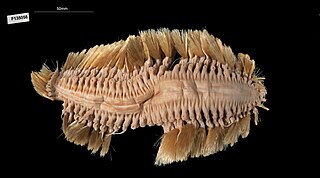
Polychaeta is a paraphyletic class of generally marine annelid worms, commonly called bristle worms or polychaetes. Each body segment has a pair of fleshy protrusions called parapodia that bear many bristles, called chaetae, which are made of chitin. More than 10,000 species are described in this class. Common representatives include the lugworm and the sandworm or clam worm Alitta.

Polynoidae is a family of marine Polychaete worms known as "scale worms" due to the scale-like elytra on the dorsal surface. Almost 900 species are currently recognised belonging to 9 subfamilies and 167 genera. They are active hunters, but generally dwell in protected environments such as under stones. The group is widely distributed from shallow intertidal waters to hadal trenches. They are the most diverse group of polychaetes in terms of genus number and second most diverse in terms of species number which is almost 8% of all segmented worm species.

Phyllodocida is an order of polychaete worms in the subclass Aciculata. These worms are mostly marine, though some are found in brackish water. Most are active benthic creatures, moving over the surface or burrowing in sediments, or living in cracks and crevices in bedrock. A few construct tubes in which they live and some are pelagic, swimming through the water column. There are estimated to be more than 4,600 accepted species in the order.
Adyte hyalina is a species of marine annelids in the family Polynoidae and the only accepted species in the genus Adyte. Adyte hyalina occurs in the North-east Atlantic Ocean and Mediterranean Sea, at depths down to about 150 metres.

Lepidasthenia is a genus of marine Polychaete worms belonging to the family Polynoidae. Species of Lepidasthenia are found worldwide to depths of about 1200 m but are more common in shallower water.

Eunoe is a genus of marine annelids in the family Polynoidae. The genus includes 48 species which are found world-wide, mostly from depths of 50 m or more.

Eunoe leiotentaculata is a scale worm known from southern Australia and New Zealand and the South Pacific Ocean at depths of 500–1200 m.

Acanthicolepis is a genus of marine annelids in the family Polynoidae. The genus was described in 1990 and includes two short-bodied species with up to 50 segments and which occur in the Mediterranean Sea and North-east Atlantic Ocean.
Australaugeneria is a genus of marine annelids in the family Polynoidae. The genus includes 4 species which are commensal on octocorals.

Eulagisca uschakovi is a giant scale worm known from the Antarctic, in waters such as off Mac.Robertson Land, Palmer Archipelago and the Weddell Sea, at depths of 10 to 920m.
Bathyadmetella is a genus of marine annelids in the family Polynoidae. The only species in the genus, Bathyadmetella commando, is known from a single specimen collected at 1646m in the north-west Pacific Ocean.
Benhamipolynoe is a genus of marine annelids in the family Polynoidae. The genus is known from the Pacific and Atlantic Oceans and includes 2 species.
Parahololepidella is a genus of marine annelids in the family Polynoidae. The genus contains a single species, Parahololepidella greeffi, This species is known from the east equatorial Atlantic Ocean and Cape Verde Islands at a maximum depth of 30m.
Polyeunoa is a genus of marine annelids in the family Polynoidae. The genus contains two species, one from the Indian Ocean and the other widespread in the south-west Atlantic ocean and the Southern Ocean.
Eulagisca macnabi is a scale worm that occurs in the Antarctic Ocean, the Amundsen Sea and off the South Orkney Islands at depths of about 300 to 1500m.
Bylgides is a genus of marine annelids in the family Polynoidae. The genus contains 9 species, all found in the Northern Hemisphere and from shallow inshore waters to depths of about 5000 m.
Pareulagisca is a genus of marine annelids in the family Polynoidae. The genus contains a single species, Pareulagisca panamensis, known from a single specimen, collected intertidally in Panama in the Pacific Ocean.
Gattyana is a genus of marine annelids in the family Polynoidae. The genus includes 11 species, 9 of which occur in the northern hemisphere, the remaining two are from the Indian Ocean off Mozambique and the Southern Ocean off New Zealand. Species of Gattyana are known from shallow water down to depths of about 1200 m.
Hermadionella is a genus of marine polychaete worms belonging to the family Polynoidae, the scaleworms. Hermadionella contains 3 species which are known from the north-west Pacific and Arctic Oceans from the intertidal to depths of about 200 m.
Bathynoe is a genus of marine annelids in the family Polynoidae. The genus includes two species, both known from depths of about 5000 m.







